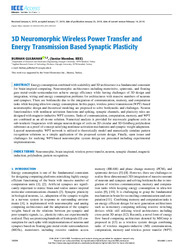3D neuromorphic wireless power transfer and energy transmission based synaptic plasticity
| dc.contributor.author | Gülbahar, Burhan | |
| dc.date.accessioned | 2020-08-31T11:35:32Z | |
| dc.date.available | 2020-08-31T11:35:32Z | |
| dc.date.issued | 2019 | |
| dc.identifier.issn | 2169-3536 | en_US |
| dc.identifier.uri | http://hdl.handle.net/10679/6870 | |
| dc.identifier.uri | https://ieeexplore.ieee.org/document/8626110 | |
| dc.description.abstract | Energy consumption combined with scalability and 3D architecture is a fundamental constraint for brain-inspired computing. Neuromorphic architectures including memristive, spintronic, and floating gate metal-oxide-semiconductors achieve energy efficiency while having challenges of 3D design and integration, wiring and energy consumption problems for architectures with massive numbers of neurons and synapses. There are bottlenecks due to the integration of communication, memory, and computation tasks while keeping ultra-low energy consumption. In this paper, wireless power transmission (WPT)-based neuromorphic design and theoretical modeling are proposed to solve bottlenecks and challenges. Neuron functionalities with nonlinear activation functions and spiking, synaptic channels, and plasticity rules are designed with magneto-inductive WPT systems. Tasks of communication, computation, memory, and WPT are combined as an all-in-one solution. Numerical analysis is provided for microscale graphene coils in sub-terahertz frequencies with unique neuron design of coils on 2D circular and 3D Goldberg polyhedron substrates as a proof-of-concept satisfying nonlinear activation mechanisms and synaptic weight adaptation. Layered neuromorphic WPT network is utilized to theoretically model and numerically simulate pattern recognition solutions as a simple application of the proposed system design. Finally, open issues and challenges for realizing WPT-based neuromorphic system design are presented including experimental implementations. | en_US |
| dc.description.sponsorship | Vestel Electronics Inc., Manisa, Turkey | |
| dc.language.iso | eng | en_US |
| dc.publisher | IEEE | en_US |
| dc.relation.ispartof | IEEE Access | |
| dc.rights | openAccess | |
| dc.title | 3D neuromorphic wireless power transfer and energy transmission based synaptic plasticity | en_US |
| dc.type | Article | en_US |
| dc.description.version | Publisher version | en_US |
| dc.peerreviewed | yes | en_US |
| dc.publicationstatus | Published | en_US |
| dc.contributor.department | Özyeğin University | |
| dc.contributor.authorID | (ORCID 0000-0003-3756-3280 & YÖK ID 234525) Gülbahar, Burhan | |
| dc.contributor.ozuauthor | Gülbahar, Burhan | |
| dc.identifier.volume | 7 | en_US |
| dc.identifier.startpage | 16594 | en_US |
| dc.identifier.endpage | 16615 | en_US |
| dc.identifier.wos | WOS:000459281200001 | |
| dc.identifier.doi | 10.1109/ACCESS.2019.2895210 | en_US |
| dc.subject.keywords | Neuromorphic | en_US |
| dc.subject.keywords | Brain-inspired | en_US |
| dc.subject.keywords | Wireless power transfer | en_US |
| dc.subject.keywords | Neuron | en_US |
| dc.subject.keywords | Synaptic channel | en_US |
| dc.subject.keywords | Magnetic induction | en_US |
| dc.subject.keywords | Polyhedron | en_US |
| dc.subject.keywords | Pattern recognition | en_US |
| dc.identifier.scopus | SCOPUS:2-s2.0-85061717290 | |
| dc.contributor.authorMale | 1 | |
| dc.relation.publicationcategory | Article - International Refereed Journal - Institutional Academic Staff |
Files in this item
This item appears in the following Collection(s)
Share this page



